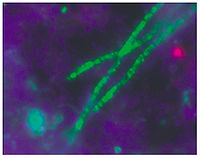
Photo from wikipedia
The Acidobacteria is one of the major bacterial phyla in soils and peatlands. The currently explored diversity within this phylum is assigned to 15 class-level units, five of which contain… Click to show full abstract
The Acidobacteria is one of the major bacterial phyla in soils and peatlands. The currently explored diversity within this phylum is assigned to 15 class-level units, five of which contain described members. The ecologically relevant traits of acidobacteria from different classes remain poorly understood. Here, we compared the patterns of acidobacterial diversity in sandy soils of tundra, along a gradient of increasing vegetation–unfixed aeolian sand, semi-fixed surfaces with mosses and lichens, and mature soil under fully developed plant cover. The Acidobacteria-affiliated 16S rRNA gene sequences retrieved from these soils comprised 11 to 33% of total bacterial reads and belonged mostly to members of the classes Acidobacteriia and Blastocatellia, which displayed opposite habitat preferences. The relative abundance of the Blastocatellia was maximal in unfixed sands and declined in soils of vegetated plots, showing positive correlation with soil pH and negative correlation with carbon and nitrogen availability. An opposite tendency was characteristic for the Acidobacteriia. Most Blastocatellia-affiliated reads belonged to as-yet-undescribed members of the family Arenimicrobiaceae, which appears to be characteristic for dry, depleted in organic matter soil habitats. The pool of Acidobacteriia-affiliated sequences, apart from Acidobacteriaceae- and Bryobacteraceae-related reads, had a large proportion of sequences from as-yet-undescribed families, which seem to specialize in degrading plant-derived organic matter. This analysis reveals sandy soils of tundra as a source of novel acidobacterial diversity and provides an insight into the ecological preferences of different taxonomic groups within this phylum.
Journal Title: PLoS ONE
Year Published: 2020
Link to full text (if available)
Share on Social Media: Sign Up to like & get
recommendations!